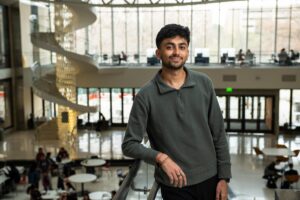Anita Husen is a graduate student in Arabic Studies. She lived in Cairo, Egypt from 2009-2010, where she studied Arabic in the university-affiliated Center for Arabic Study Abroad program. Prior to coming to the university, she was a Peace Corps volunteer in Morocco. After graduation, she hopes to go back to Cairo to continue studying and teaching Arabic.
In a military state with martial law, an innocent 28-year old Egyptian, Khaled Said, was beaten to death by state security. His post-mortem photo circulated the Internet and started a movement by Egypt’s Facebook generation. Fed up with police brutality, Egyptians from across the political spectrum demanded basic human rights.
Egyptian youth signed in to social networks, organized and strategized peaceful demonstrations on main streets, crowded neighborhoods, and large squares in major cities for Jan. 25, the national Police Day holiday.
Protesters carried flowers as symbols of peace, chanted the slogan “peaceful, peaceful,” and shielded themselves with tin lids and spray paint in case of police attacks. These young men and women shattered the orientalist stereotypes about the Middle East: that democracy is inherently incompatible with Islam, that Arabs are naturally violent, and that the only path to democracy in the Middle East is its import by Western military invasion.
As protesters took to the streets in unprecedented numbers, the neighbors who had been watching from their windows and balconies began to join in. The call for economic justice, freedom, end of martial law, and basic human dignity resonated with every segment of the Egyptian population; young and old, Muslim and Christian, men and women, rich and poor, illiterate and educated.
Unprecedented, too, was the response of a fearful and weak regime. In an attempt to silence the voice of the people, it shut down cell phone use on Jan. 28 and all Internet access for several days. However, these methods backfired as Egyptians used ingenuity to circumvent the blocks and broadcast the peacefulness of the demonstrators and the violence of the police on Facebook, YouTube, Twitter, and live-streaming on satellite news stations like Al-Jazeera. The government tactics of intimidation echoed attempts to quell the Civil Rights movement in America, like using water cannons to drown out peaceful protests.
Protests grew larger by the day. The universal appeal of the movement crossed religious and political affiliations. Christian and Muslim Egyptians protected each other from police forces during prayers and sermons. Like the struggles to end apartheid in South Africa and British colonial rule in India, Egyptian protesters were calling for basic human rights, as expressed by their slogans and signs.
Only this time, the world was watching via live streaming and mobile uploads. Major cities across the world held rallies to support the call for democracy and regime change in Egypt, including two support rallies at the Capitol building in Austin. Eighteen days after the protests began, the president of Egypt resigned.
The success of Egypt’s new government depends on its ability to reflect the plurality and democratic demands of its people. And its success has the potential to inspire citizens of oppressive regimes in the Middle East, Asia, Africa, and all over the world to sign on, sign in and “friend” freedom.
Read the rest of the essays in this series on perspectives on Egypt.



